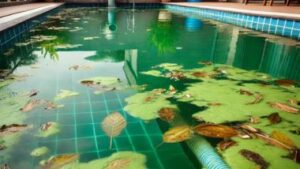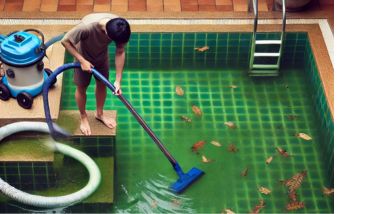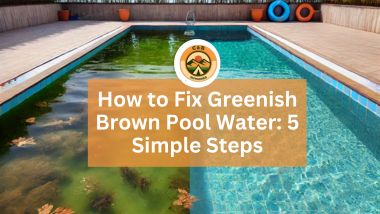Greenish brown pool water isn’t always a sign of algae—here’s what you might be missing.What causes this unsettling color, and more importantly, how can you fix it?
If you’ve found yourself staring at murky water that looks more like a pond than a refreshing oasis, you’re not alone!
In this post, we’ll uncover the surprising reasons behind that greenish brown hue and guide you through effective steps to restore your pool to its sparkling best.
Understanding Greenish Brown Pool Water

Greenish brown pool water is a murky blend of colors that can result from a variety of factors.
Unlike cloudy water, which is usually white or greyish and often caused by unbalanced water chemistry, greenish brown water has a distinct tint that indicates specific problems such as algae growth, metal contamination, or poor filtration.
Common Causes of Greenish Brown Pool Water
Algae Growth: Algae are one of the most common reasons for a greenish tint. Algae thrive in warm water with insufficient chlorine levels, quickly spreading and turning your pool green.
Iron and Metals: Iron is notorious for causing brown discoloration. It can enter your pool from sources like well water, rusted pipes, or even old pool equipment. When combined with other elements in the pool, iron gives water a greenish brown appearance.
Poor Water Circulation and Filtration: If your pool’s filtration system isn’t functioning properly, it may struggle to keep contaminants like algae and metals out of the water, resulting in discoloration.
High Levels of Organic Matter: Debris such as leaves, pollen, or dirt can decompose in the pool, releasing substances that lead to murky water. This organic matter contributes to water discoloration if not promptly removed.
Identifying the Signs of Contaminants:
If your pool has developed greenish brown water, you’ll need to identify the cause to treat it effectively. Here are a few common signs:
Stains: Brown stains on your pool walls or floor could indicate the presence of metals like iron.
Reddish Tint: A slight reddish hue along with the brown could be a tell-tale sign of iron contamination in the pool.
Fixing Greenish Brown Pool Water: 5 Simple Steps

Have you ever stepped outside to find your sparkling pool transformed into a murky mess of greenish brown pool water?
It’s a common issue that can leave pool owners scratching their heads. But don’t worry; you’re not alone in this battle against discoloration!
Let’s get into the five simple steps to restore your pool’s clarity and make it inviting again.
1. Test Your Pool Water
The first step in tackling greenish brown pool water is to test your pool water for pH, chlorine levels, and metal content. You can use test strips or a liquid testing kit to get accurate readings.
- Chlorine Level: Ensure your chlorine levels are within the recommended range (1-3 ppm). Low chlorine can allow algae and bacteria to thrive, contributing to that unpleasant color.
- pH Level: Check the pH level, which should ideally be between 7.2 and 7.8. An unbalanced pH can affect chlorine efficiency and lead to water issues.
- Iron Presence: If you suspect metals are the culprit, specifically iron, it’s crucial to test for their presence. High iron levels often lead to brown stains and discoloration.
2. Shock Your Pool
Once you have your test results, it’s time to shock your pool. Shocking the pool introduces a high dose of chlorine, which helps to eliminate algae and bacteria that can cause the water to appear greenish brown.
How to Shock: Follow the instructions on your shock treatment product, as the dosage may vary. Typically, you’ll want to add 1 pound of shock per 10,000 gallons of water.
Distribute the shock evenly across the surface of the pool while the pump is running to ensure proper circulation.
3. Brush and Vacuum
After shocking, take a moment to brush the walls and floor of your pool. This step is crucial because it helps to remove algae and debris that may be clinging to the surfaces.
- Brushing Technique: Use a pool brush suited for your pool type (vinyl, tile, or plaster). Focus on areas that tend to collect dirt or algae, such as corners and steps.
- Vacuuming: Once you’ve brushed the pool, use a vacuum to remove debris. A manual vacuum is effective for tackling stubborn spots, while an automatic pool cleaner can help maintain clarity over time.
4. Use a Pool Clarifier
After brushing and vacuuming, consider adding a pool clarifier. This product helps to bind tiny particles and contaminants together, allowing your filter to capture them more easily.
- Application: Follow the manufacturer’s instructions for dosing. Usually, you’ll add the clarifier directly to the pool while the pump is running, allowing for maximum circulation and effectiveness.
5. Run Your Filter
The final step in clearing up greenish brown pool water is to run your filter continuously for at least 24 hours. This ensures that the water is being properly circulated and filtered, allowing the chemicals and clarifier to work effectively.
Filter Maintenance: Check your filter regularly and clean it according to the manufacturer’s recommendations. A clean filter is essential for maintaining clear water and preventing future issues.
Regular Maintenance Tips:

To keep your pool water clear, test for metals regularly, especially if you use well water. Clean and replace filters as needed to ensure they’re effectively removing contaminants.
To prevent future issues with greenish brown pool water, establish a regular pool maintenance routine.
Skim the pool daily to remove organic matter, brush the walls, and vacuum the floor weekly. Always test your pool’s chlorine and pH levels to ensure they’re within the proper range.
Within 24 hours, you should notice a significant improvement in water clarity. Depending on the severity of the issue, it may take an extra day or two to fully resolve the problem.
Conclusion
Greenish brown pool water can be an eyesore, but with proper maintenance and troubleshooting, it’s an issue that’s entirely fixable.
By understanding the causes—whether it’s algae, metals like iron, or poor circulation—you can take proactive steps to prevent this from happening again.
Follow the five steps outlined above to remove iron, clean a green pool in 24 hours, and maintain the clarity of your pool. With regular care, your pool will remain a welcoming, clear retreat all season long!
